The three great pyramids of giza
Located at the city of Giza, a necropolis (cemetery) of ancient Memphis, presently part of Greater Cairo, Egypt.
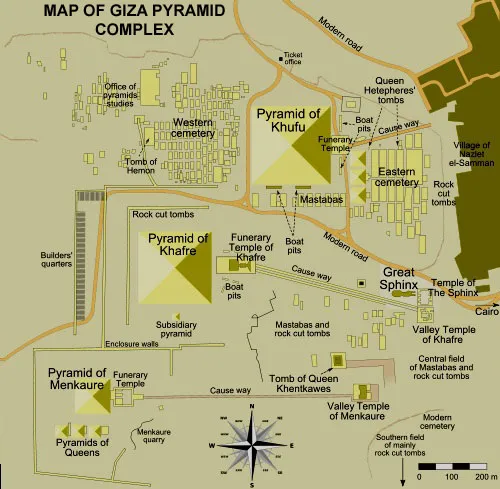
Map of Giza Pyramid Complex
- The three great pyramids of Giza consist of the pyramids for Kings Khufu (Cheops), Kherfe (Chepren), and Menkaure (Mykerinos).
- The Great Pyramid of Khufu is listed as one of the Seven Ancient Wonders, yet it‟s the only surviving. Built by Pharaoh Khufu of the 4th Dynasty around 2560BC to serve as a tomb when he dies.
- The second pyramid belongs to the pharaoh Kherfe and it is 3 meters shorter than Khufu‟s.
- The pyramid of Menkaure is the smallest of the three pyramids (66 meters high).
- The Three Great Pyramids are now enclosed and serves as a tourist region of the Giza plateau.
- The enclosement also contains a museum housing the mysterious Sun Boat. The boat is believed to have been used to transport the body of Khufu to his burial place in the pyramid. It is also believed that the boat served him as a means of transportation in his after life journey to the world beyond.
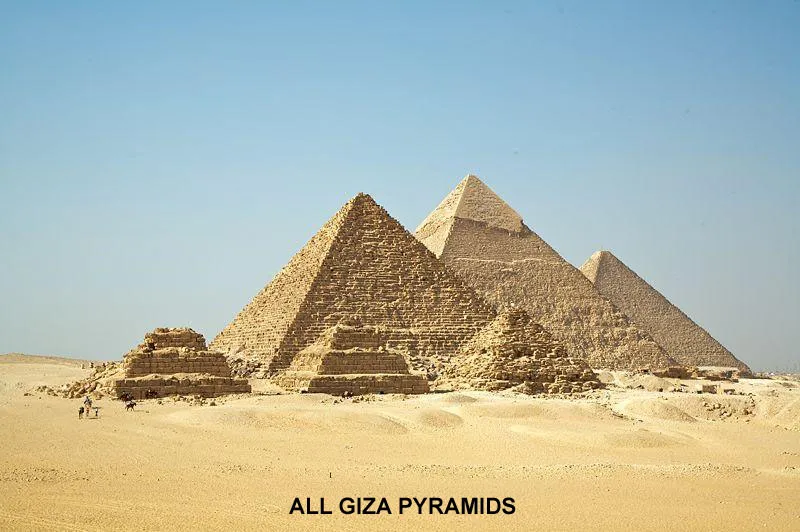
Case Study – The Great Pyramid of Khufu
- It has lost 10m off its top.
- It has world’s tallest structure for more than 43 centuries until advent of modern architecture in the 19th century.
- It has covered with white ‘casing stones’ of highly polished white limestone which caused the monument to shine brightly in the sun, making it visible from a considerable distance.
- The sloping angle of its sides is 51 degrees to the horizontal.
- Each side is oriented with one of the cardinal points of the compass i.e. north, south, east and west.
- The horizontal cross-section of the pyramid is a square at any level, with the square at the base measuring 229m x 229m.
- Each stone weighed between 2000kg (2 tons) and 5000kg (5 tons) and consists of approximately 2.5 million blocks of limestone.
- The granite stones for the King‟s Chamber were imported from Aswan (800km away) and limestones from Tura (14km away).
- It‟s estimated that the Great Pyramid of Khufu took almost 20 years to complete, due to its size and location of stone used in construction of the structure.
- It takes ages for stone masons to cut and shape each block.
- All these complicated tasks made the pyramid difficult to construct, but the results were amazing.
- It is suggested that the stone blocks in the pyramid are enough to construct a 3m high, 300mm thick wall around France.
- The entrance to the pyramid is on the north façade.
- There are a number of corridors, steps and galleries that leads to the king‟s burial chamber.
- The king‟s chamber is located at the heart of the pyramid accessible through the Great Gallery and an ascending corridor.
- The king‟s sarcophagus (a stone coffin usually with carvings) is made of red granite, including the interior walls of the chamber.
- All the interior stone blocks fit so well that a card won‟t fit between them!!!
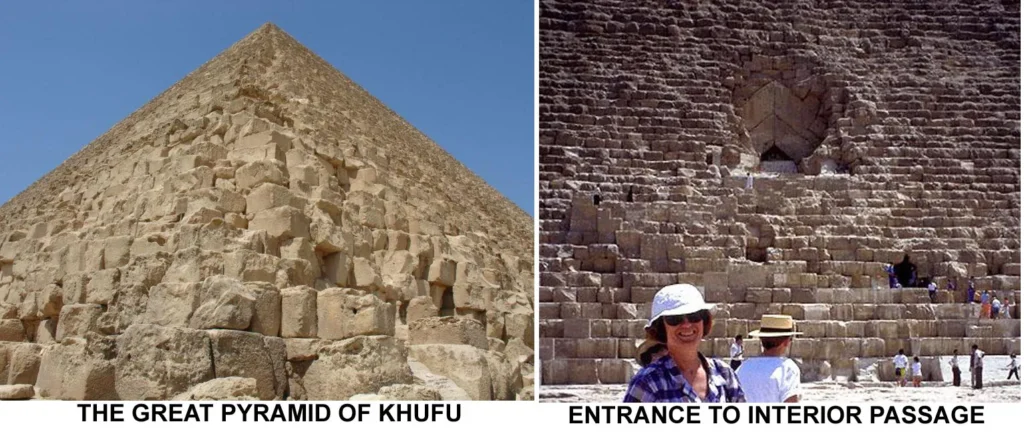
How were the Pyramids Built?
- The construction of the pyramids has been a puzzle to scientists for centuries.
- No clues have given archaeologists answers about the construction of the pyramids.
- Evidence have it that the site was first prepared, and stone blocks were transported and placed.
- However, it is not known how the stone blocks were transported and placed.
- Built by labourers as a kind of tax that had to be paid by everyone supervised by skilled artisans
- Construction took place during 3-4 months of the year when the Nile was flooded.
- Several theories have been proposed on how the pyramids were constructed.
Theory – 1
- The most common theory for moving the large stone blocks was to slide logs under them to make mobility easier.
- Strong ropes were used to pull the stone blocks with several people pushing the block forward, while several men would remove the last log uncovered by the stone.
- The end log removed was then transferred to the front where it would complete the cycle under the stone, until it went to the back again.
- Moving the block was one challenge, pacing it into position was a greater one.
Theory – 2
- The most common theory for placement of each stone is to have a ramp (straight or spiral) that went right around the pyramid‟s sides that was raised as the construction proceeded.
- The ramp is believed to have been coated with mud and water to ease the movement of the stone blocks as they were pushed or pulled (or both).
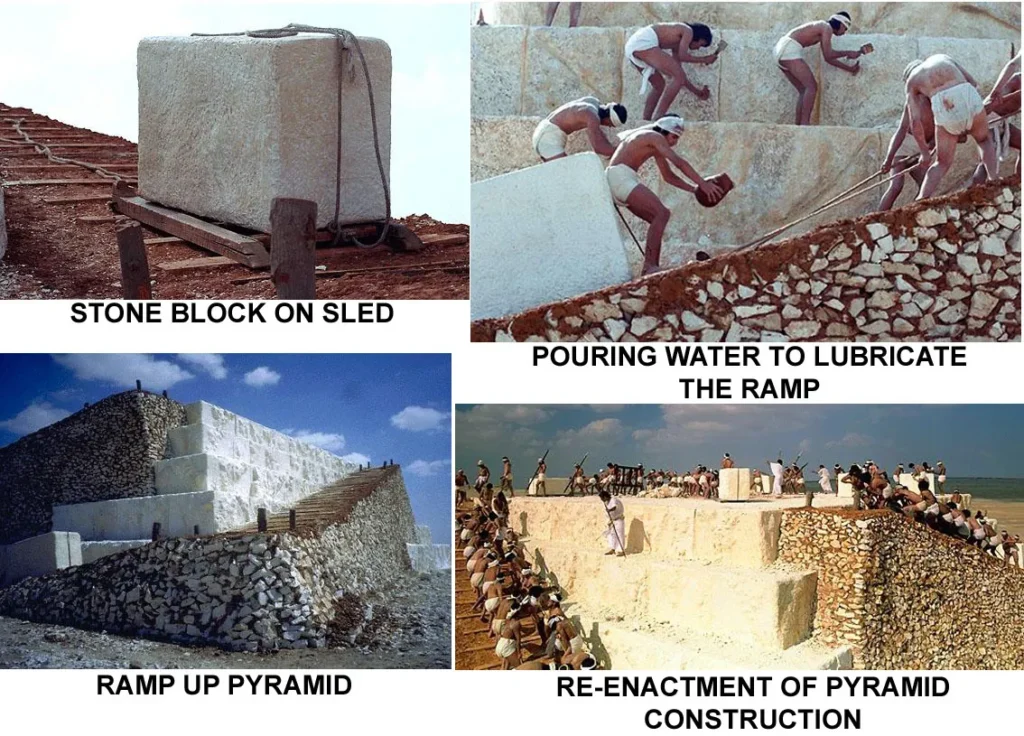
The Pyramids Interior
King‟s Chamber
- The chamber is about 5.25m x 10.5m x 6m tall, and was built with solid stone blocks of granite that weighs about 50,000kg.
- Consists of a sarcophagus (2.1m x 900mm) with smooth walls and polished ceiling.
- Floor is about 60sqm, made with blocks of pink Aswan granite. transported from Aswan from the south.
- Archaeologists concluded that the sarcophagus was built inside the pyramid because it would have been almost impossible to transport such a heavy stone structure in such a confined and narrow passage.

Grand Gallery
- It rises gradually to the king’s chamber with a stepped hall.
- The hall is 48m long, 3m wide and 11m high and 26 degrees to the horizontal.
- The walls were made of polished stone with roofing that overlaps stone blocks to create a stepped effect.
- These were thought to be a ramp for large giant blocks to seal the pyramid for eternity.
- The bottom of the gallery hall as an entrance to the Queen‟s chamber; and at the top of the hall is an entrance to the king‟s chamber.

Queen’s Chamber
- Located under the king’s chamber and the smallest of the three.
- Its name has falsely led people into believing that this room held the mummy of a queen.
- The true purpose of the chamber, however, remains uncertain.
- The chamber is closed to public and cannot be accessed by tourists for viewing.
- It measures approximately 5.74 by 5.23 meters, and 4.57 meters in height.
Underground Chamber
- The oldest chamber in the pyramid.
- The largest of the three, never fully completed and has very little oxygen.
- The low oxygen level makes it impossible to burn lanterns and make it very difficult to breathe.
Shafts
- They are believed to allow air to proceed into the king’s chamber.
- Also believed to lead to the path of the star, which allows the pharaoh’s soul to escape to the afterlife.
- Extends about 145m outward and travel in a sloping path.
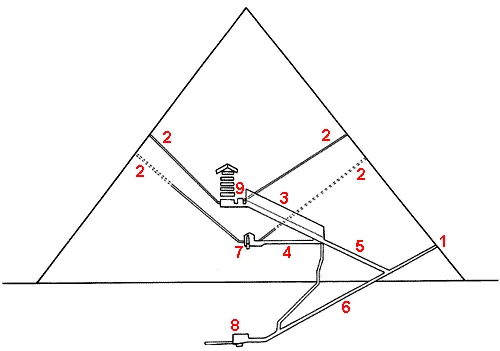
Cross Section – Pyramid of Khufu (Cheops)
(1. Entrance, 2. Air Shafts, 3. Grand Gallery, 4. Horizontal Passage, 5. Ascending Passage, 6. Descending Passage, 7. Queens Chamber, 8. Underground Chamber, 9. King’s Chamber)
Axonometric View of the Pyramid of Khufu (Cheops)

Pyramids of Giza Complex
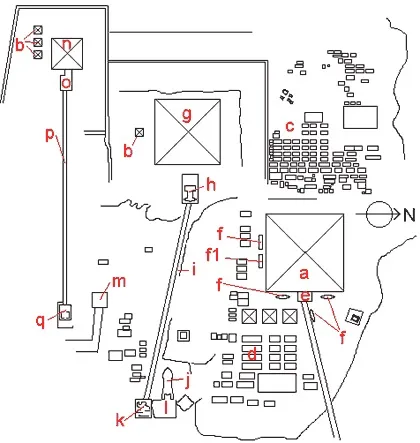
(a – Pyramid of Khufu (Cheops), b – Queens‟ Pyramid, c – Western cemetery, d – Eastern Cemetery, e – Remnants of the Valley Temple of (Khufu) Cheops, f – Pits for the Solar Ships, g – Pyramid of Khefre (Chepren), h – Mortuary Temple of Chepren, i – Causeway, j – Sphinx, k – Valley Temple of Chepren, l – Sphinx Temple, m – Monument of Queen Chentkaue, n – Pyramid of Menkaure (Mykerinos), o – Mortuary Temple of Mykerinos, p – Remnants of the Causeway, q – Remnants of the Valley Temple)
The Great Sphinx at Giza, Egypt
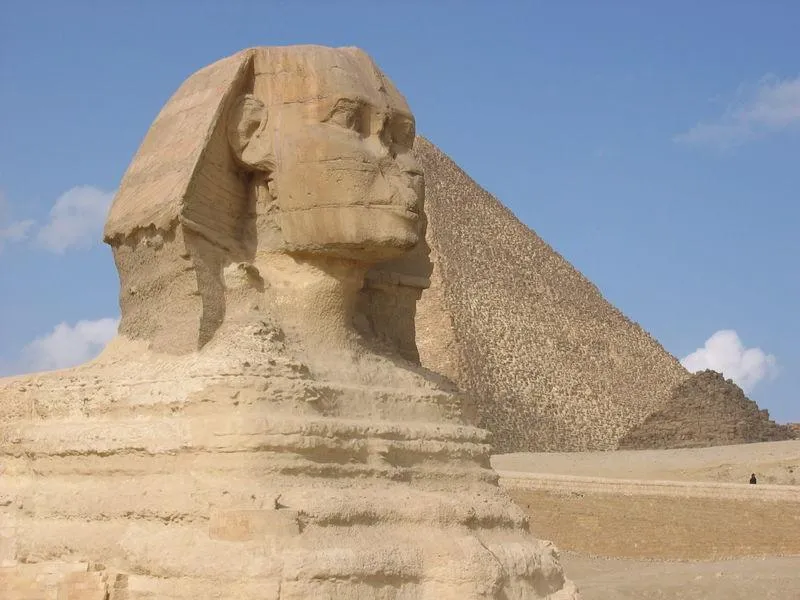
Sphinx mythologies
- Seen as a guardian deity.
- Represented with the body of a lion and head of a ram or a man, frequently a likeness of the reigning pharaoh.
- The Great sphinx is about 20m high and 73m long.
The Step Pyramid Complex of Djoser
- Built during the 3rd Dynasty (c. 2800 B.C.) in Saqqara, Egypt by Djoser about 2737-2717BC, necropolis of the capital Memphis.
- Considered the first monumental royal tomb and one of the oldest stone structures in Egypt.
- Designed by Imhotep, the first known Egyptian architect who was later deified by the Egyptians.
- Characterized by a flat-topped rectangular super-structure of stone with a shaft descending to the burial chamber far below it.
- After completion, its height was increased by building additions of diminishing size superimposed on each other.
- Thus, Djoser’s original mastaba became a terraced structure rising in six unequal steps to a height of 60m, with base measuring 120x108m.
- The substructure has an intricate system of underground corridors and rooms.
- Its main feature is a central shaft 25x8m wide at the bottom of which is the sepulchral chamber.
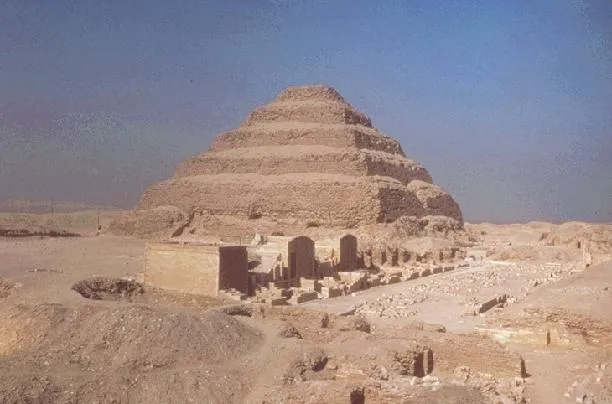
Stepped Pyramid and Heb-Sed Court
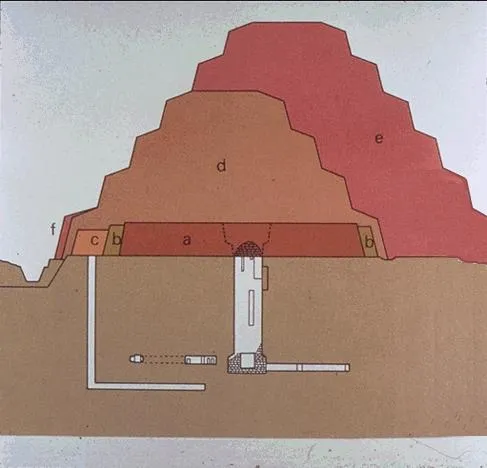
Schematic drawing of successive Step Pyramid Construction stage
ii) Private Tombs or Tombs of the Elites (Mastabas)
- Less elaborate than the royal tombs, nevertheless impressive.
- Probably given as rewards by the Pharaoh since it was a privilege to be buried near the Pharaoh.
- Courtiers and families of the monarch were also buried in these structures.
- Like the pyramids, they were built on the west side of the Nile (symbol of death).
- The deceased were laid to rest in an underground chamber at the bottom of a shaft, and a flat-topped tomb was placed over them.
1st Dynasty (2920-2770BC) private tombs consisted of mud brick underground structures that contained the burial site and a flat-topped rectangular, mud or stone superstructure built over it known as mastaba (Arabic for “bench”).
- The mastaba tombs are so named because they resemble the benches outside shops in the markets.
2nd and 3rd Dynasties private tombs, “stairway” mastaba was introduced with the tomb chamber having been sunk much deeper and cut in the rock below.
- Steps and ramps led from the top of the mastaba to connect with a shaft which descended to the level of the tomb chamber.
- After the burial, heavy stone portcullises were dropped across the approach from slots built to receive them, and this was then filled in and all surfaces traces removed.
4th Dynasty private tombs (2575–2467BC), stone mastabas began to replace those of mud bricks.
- A small offering chapel developed, with an offering room constructed within the mastaba itself.
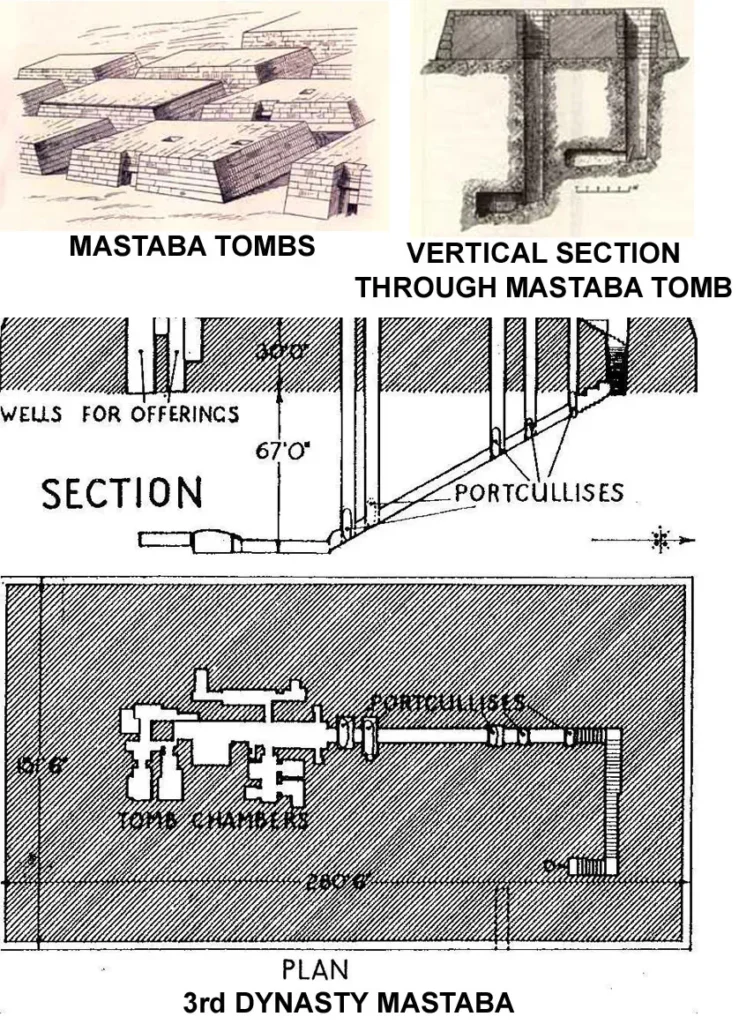
5th and 6th Dynasties (2465–2323BC and 2323–2125BC) respectively, larger mastabas of the highest officials had series of increasingly elaborate decorated rooms for performance of rituals.
- Rituals focused on false doors on the west wall which was intended to connect the worlds of the dead and the living.
- The door was solid and impassible to the living but permitted the dead to pass through and receive offerings.
- In the offering room was a stelae on which the deceased was shown seated at a table of offerings.
- The actual body of the dead was placed in a burial chamber at the bottom of a shaft cut deep into the ground below the chapel.
- After the burial, the shaft was filled in and made inaccessible.
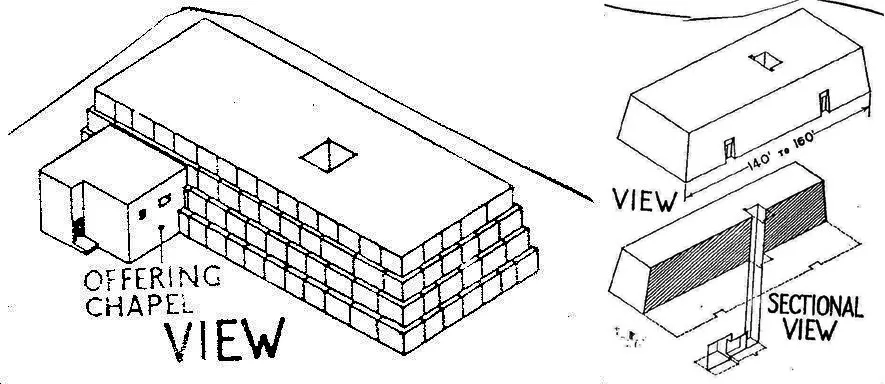
iii) Rock-cut Tomb
- Rock-cut tombs are tomb chapels which were excavated into the rocky cliffs overlooking the Nile.
- Became the most common private tomb for the nobles in the Middle Kingdom.
- They were either simple single chambers serving all the functions of the multiplicity of rooms in a mastaba or consisting of huge halls, often connecting to form a labyrinthine complex (system of intricate passageways and blind alleys that rendered egress difficult), with columns carefully cut from the rock.
- Chapels with false doors were carved out within the halls.
- The cutting is done with considerable architectural precisions.
- The tomb chapels were excavated to take a simple T-form, in which the crossbar of the “T‟ represents the entrance hall, and the upright stroke of the “T‟ is the chapel proper.
- Example is the Tombs of the Kings, Thebes.
B) Temple Architecture
Temples were places where the gods and their divine energy could reside, separated from everything else in the world.
- There are two principal kinds of temples:
- Cult temples – for the popular worship of the ancient and mysterious gods; and
- Funerary temples – shrines for the funerary cults of dead kings.
- Temple architecture began in the worship of multifarious local deities.
- The old or middle kingdom temples were built of perishable mud brick; only few have survived.
- In the 18th Dynasty, major temples were built of stones and form bulk of most surviving temples.
- The Egyptians believed that the gods occupied a different part of the universe.
- Temples were thus built as houses for the gods, where the gods appear on earth.
- Focal point of any Egyptian temple was a sanctuary area that contained a cult statue of the god.
- The statue, sanctuary and the temple were made as beautiful as possible so that the god would want to reside there.
- Most Egyptians never went inside the temples believing that the gods were different from human beings and that it was dangerous for humans to interact with gods unprotected.
- The spaces within the temple were believed to be sacred and became more sacred at the inner parts, restricted for kings and officiating priests.
- The architecture of the temple was made to replicate the universe at the moment of creation.
- Egyptians believed that before creation, there existed only the dark, marshy primeval (relating to the earliest ages) waters of confusion.
- Out of these primeval waters (nun), a mound arose on which the creator god came into being and created the ordered universe.
- The dark hypostyle hall (interior space whose roof rests on pillars or columns) with its many pillars representing the primeval waters.
- The pillars topped by papyrus or lotus capitals represented the marshy plants.
- The polished floor represented the waters itself.
- The essential layout was a rectangular palisaded court (reception pavilion) entered from a narrow end connected by a corridor on a causeway to the open court of the temple within which stood the emblem of the deity.
- Inside the further end of the court was a pavilion, comprising vestibules and sanctuary.
- Fine relief embellished the covered corridor on both sides of the court.
- Procession was a common feature of the cult temples; hence free circulation was required through or around the sanctuary.
Temple at Abu Simbel
- Four colossal, seated statues of Ramses II flank the entrance to the larger of the two temples carved into a sandstone cliff at Abu Simbel, Egypt, in about 1250 BC.
- Such large-scale projects as the construction of temples and pyramids were carried out by the general populace, and their work was treated as a form of taxation.
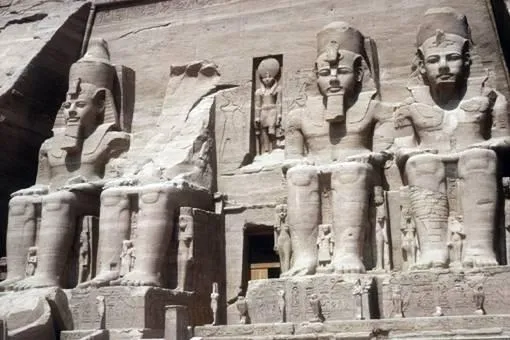
Temple at Luxor
- The ancient Egyptian temple at Luxor, on the east bank of the river Nile, was begun in the 1200s BC and was added to by each succeeding dynasty.
- It was connected to the temple at Karnak by a causeway about 3.5 km (2 mi) long, lined with hundreds of sphinxes.
- Once a year the image of the god Amon was transported by barge from Karnak to Luxor, as part of a huge festival.

Hypostyle Hall, Luxor Temple

Statue of Rameses II with Pillars of Luxor Temple
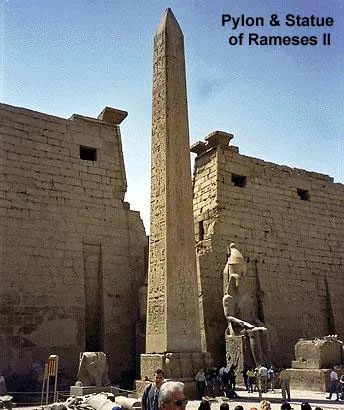
Pylon & Statue of Rameses II
Temple at Karnak
- The temple of Karnak was built on the Nile at Luxor by a succession of Egyptian rulers.
- It comprises a series of courts, monumental gateways, obelisks, and high perimeter walls.
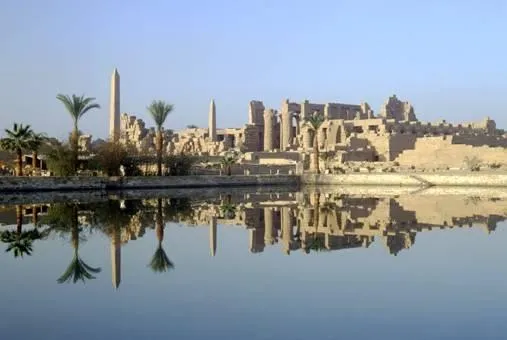
Temple at Karnak showing the close relationship between Egyptian civilization and the Nile.

Karnak Temple Exterior
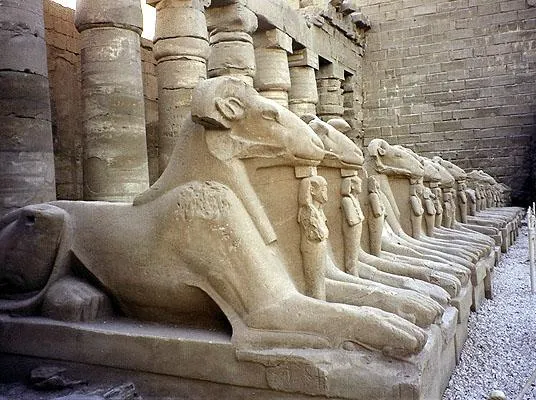
Avenue of Sphinxes
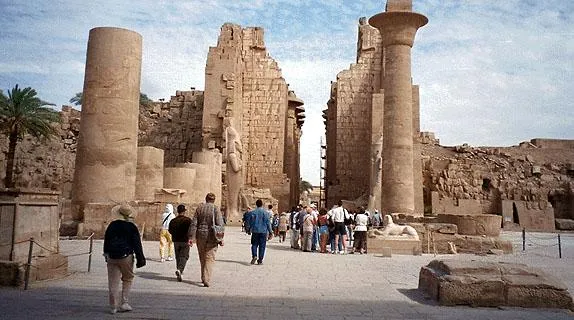
Ruins of Karnak Temple
C) Domestic Architecture
- It is Includes houses and palaces.
- Mud brick and wood were the standard materials for houses and palaces except in rare cases in which stone was used.
Houses
- Commoners dwelling were of crude brick, one or two storey high.
- Mansions of the powerful thou palatial, were built of the same materials.
- Foundations were generally non existent; virgin soil above groundwater level was baked rock hard by the sun and needed just some levelling.
- In order to build on top of collapsed dwellings, the clay rubble was well watered and let to set and harden.
- Wall width was about 400mm for one storey and up to 1.25m for multi-storey buildings. Beams were let into the walls to reinforce them.
- In substantial houses, rooms were arranged around an inner courtyard or on either side of a corridor.
- Wall facing the street often had only one opening, the door, though windows might be let into the upper storey walls.
- Windows were small, covered with shutters or mats in order to keep out the flies, dust, and heat.
- Windows were placed high to reduce sunlight.
- Typical worker’s house had ( 2 – 4 ) rooms on the ground floor, an enclosed yard, which acted as a kitchen, and 2 cellars for storage. Niches in the walls held religious objects.
- The roof reached by an open staircase served as additional living space and for storage.
- Many people slept on the flat roof during the summer to keep cool. Cooking was also often done on the roof.
- Finer houses had reception rooms and private quarters, while some even had bathrooms and toilets.
- Toilet seats were made of limestone while others used toilet stools.
- Households disposed off their sewage in pits, in the river or in the streets.
- The houses typically had three or four rooms, comprising a master bedroom; a reception room, a cella for storage, and a kitchen open to the sky.
- The reception suite is normally located on the cooler, north side of the house.
- Villas for important officials were largely and finely decorated with brightly painted murals.
- They had various rooms including separate apartments for the master, his family, and his guests.
- Such houses had bathrooms and lavatories.
- Where space allowed, mansions were built, laid out formally with groves, gardens, and pools
- The ceilings of large rooms were supported by painted wooden pillars.
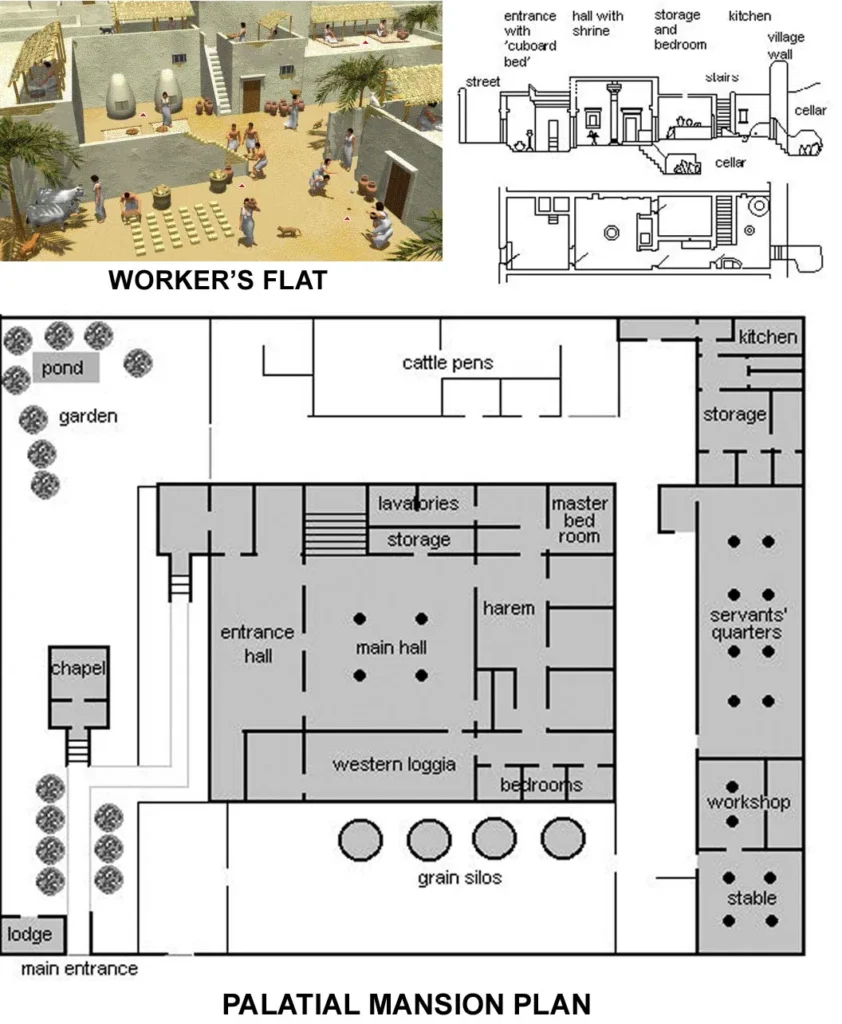
Palaces
- For administrative functions of governance and religious duties of the pharaoh.
- Most were built of mud bricks and hence, have not survived well.
- The nature of the Egyptian king was very complex and so were his needs.
- His body housed the royal ka-spirit which transmitted divine aspects of kingship from one king to the next.
- The king also represents the earthly manifestation of various deities such as Ra (the sun god), or Horus (the god of the sky).
- Just like in temples, an entrance way led into an open court followed by a pillared hall, followed by the throne room.
- The king’s throne was on a raised platform at the center of the back wall.
- The throne sat within the kiosk that took the place of a shrine in a temple’s sanctuary.
- The enthroned king was therefore equivalent to the cult statue of a god.
- In Egyptian belief, foreign lands and their inhabitants represented the forces of confusion.
- Images of bound foreigners were painted on the steps leading to the throne platform and on the platform itself.
- As the king ascended the platform, he walked on these images and sat on them.
- The foreigners lay under his feet in subjection, symbolizing the triumph of the king over the forces of confusion.
In conclusion, Egyptian architecture is an enduring and fascinating aspect of human history, reflecting the technological, artistic, and cultural achievements of one of the world’s oldest civilizations. Its influence can still be seen in modern architecture, and its legacy continues to inspire and awe people all over the world.